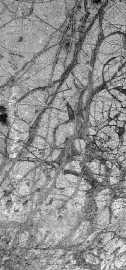This is an image of Europa showing what may be plates floating on a subsurface ocean.
Click on image for full size
NASA
Europa Tectonism
The surface of Europa was carefully examined for types of faulting and fracture. These provide evidence of the kind of stress (pushing and shoving) which the crust of Europa has undergone through time. The type of stress in turn provides evidence of the type of tectonism which characterizes Europa.
Examination of the surface of Europa shows evidence of icy-volcanism:
- smooth, unmodified plains
- lobate flow fronts
- flooded terrain (see lobate flow fronts)
- pyroclastic mantling
- plates (example shown here)
- strike/slip faulting (similar to that of the Earth's surface)
Examination of the surface also shows a relatively uniform cratering pattern remeniscent of that of Venus & Earth.
This style of icy-volcanism proves to be different from either that of Callisto or Ganymede. (The other major moon of Jupiter, Io has a more conventional form of volcanism.) The difference has to do with processes in the interior of Europa
You might also be interested in:
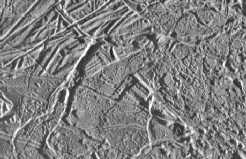
This is an example of terrain of Europa which has been flooded by fresh water which subsequently re-froze on the surface. The edges of the flow are "lobate" meaning rounded like a puddle of water. This
...more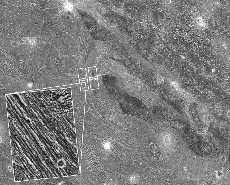
There has been no icy volcanism on Ganymede, but it does seem that there has been a kind of tectonism, or surface motion. Examination of the surface of Ganymede reveals many kinds of faulting and fracture.
...more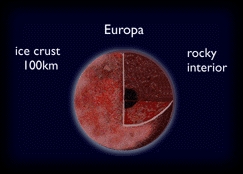
The diagram shows possibilities for the interior structure of Europa. There is a core of rocky material buried inside, overlain with ice of various phases. The diagram shows that there may be an ocean
...more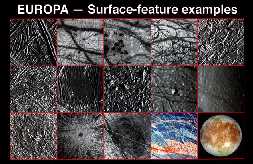
The picture to the left shows examples of the many amazing different surface features of Europa. Many exciting discoveries were made about Europa during the Galileo mission. The surface of Europa is unusual,
...more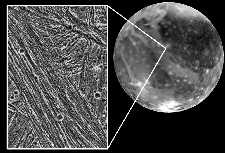
Instead of icy-volcanism, the surface of Ganymede reveals a gradual surface deformation remeniscent of the crustal deformation of the Earth. In this case, crustal extension of the surface of Ganymede resulted
...more
Amalthea was discovered by E Barnard in 1872. Of the 17 moons it is the 3rd closest to Jupiter, with a standoff distance of 181,300 km. Amalthea is about the size of a county or small state, and is just
...more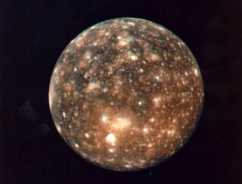
Callisto was first discovered by Galileo in 1610, making it one of the Galilean Satellites. Of the 60 moons it is the 8th closest to Jupiter, with a standoff distance of 1,070,000 km. It is the 2nd largest
...more


